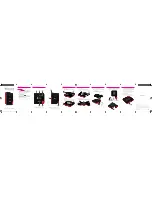
Chapter 7. Advanced Settings (Part 1)
|
119
N300 Wireless Dual Band ADSL2+ Modem Router DGND3300v2 User Manual
Setting Up a Default DMZ Server
The default DMZ server feature is helpful when using some online games and
videoconferencing applications that are incompatible with Network Address Translation
(NAT). The N300 wireless modem router is programmed to recognize some of these
applications and to work correctly with them, but there are other applications that might not
function well. In some cases, one local computer can run the application correctly if that
computer’s IP address is entered as the default DMZ server.
WARNING!
DMZ servers pose a security risk. A computer designated as the
default DMZ server loses much of the protection of the firewall
and is exposed to exploits from the Internet. If compromised, the
DMZ server computer can be used to attack other computers on
your network.
Incoming traffic from the Internet is usually discarded by the N300 wireless modem router
unless the traffic is a response to one of your local computers or a service that you have
configured in the Port Forwarding screen. Instead of discarding this traffic, you can have it
forwarded to one computer on your network. This computer is called the default DMZ server.
The WAN Setup screen lets you configure a default DMZ server.
To assign a computer or server to be a default DMZ server:
1.
In the last Default DMZ Server field, type the last digit of the IP address for that
computer. To remove the default DMZ server, enter
0
(zero).
2.
Select the
Default DMZ Server
check box, and click
Apply
.
Setting Up Quality of Service (QoS)
Quality of Service (QoS) is an advanced feature that can be used to prioritize some types of
traffic ahead of others. The N300 wireless modem router can provide QoS prioritization over
the wireless link and on the Internet connection.
The N300 wireless modem router supports Wi-Fi Multimedia Quality of Service (WMM QoS)
to prioritize wireless voice and video traffic over the wireless link. WMM QoS provides
prioritization of wireless data packets from different applications based on four access
categories: voice, video, best effort, and background. For an application to receive the
benefits of WMM QoS, both it and the client running that application must be WMM enabled.
Legacy applications that do not support WMM, and applications that do not require QoS, are
assigned to the best effort category, which receives a lower priority than voice and video.
















































